Reflect介紹:
Reflect這個物件在我的node(v4.4.3)中還沒有實作, babel(6.7.7)也沒有實作,新版本的chrome是支援的, ff比較早就支持Proxy和Reflect了,要讓node支援Reflect可以安裝harmony-reflect ;
Reflect不是建構函數, 要使用的時候直接透過Reflect.method()調用, Reflect有的方法和Proxy差不多, 而且多數Reflect方法原生的Object已經重新實作了。
什麼要使用Reflect
這裡列舉幾個為什麼要使用Reflect的原因, 譯文位址:Reflect , 大概翻譯了一遍:
##1:更有用的回傳值: Reflect有一些方法和ES5中Object方法一樣樣的, 例如: Reflect.getOwnPropertyDescriptor和Reflect.defineProperty, 不過, Object.defineProperty(obj, name, desc)執行成功會回傳obj, 以及其它原因導致的錯誤, Reflect .defineProperty只會回傳false或true來表示物件的屬性是否設定上了, 如下程式碼可以重構:try {
Object.defineProperty(obj, name, desc);
// property defined successfully
} catch (e) {
// possible failure (and might accidentally catch the wrong exception)
}重構成這樣:if (Reflect.defineProperty(obj, name, desc)) {
// success
} else {
// failure
}其餘的方法, 例如Relect.set , Reflect.deleteProperty, Reflect.preventExtensions, Reflect.setPrototypeOf, 都可以進行重構;2:函數操作, 如果要判斷一個obj有定義或者繼承了屬性name, 在ES5中這樣判斷:name in obj ; 或刪除一個屬性:delete obj[name], 雖然這些很好用, 很簡短, 很明確, 但是要使用的時候也要封裝成一個類別;有了Reflect, 它幫你封裝好了, Reflect.has(obj, name), Reflect.deleteProperty(obj, name);3:更可靠的函數式執行方式: 在ES中, 要執行一個函數f,並給它一個參數args, 還要綁定this的話, 要這麼寫:f.apply(obj, args)但是f的apply可能被重新定義成用戶自己的apply了,所以還是這樣寫比較可靠:
Function.prototype.apply.call(f, obj, args)上面這段程式碼太長了, 而且不好懂, 有了Reflect, 我們可以更短更簡潔明了:
Reflect.apply(f, obj, args)4:可變參數形式的建構子: 想像一下, 你要透過不確定長度的參數實例化一個建構函數, 在ES5中, 我們可以使用擴展符號, 可以這麼寫:
var obj = new F(...args)不過在ES5中, 不支援擴充符啊, 所以, 我們只能用F.apply,或F.call的方式傳不同的參數, 可惜F是一個構造函數, 這個就坑爹了, 不過有了Reflect, 我們在ES5中能夠這麼寫:
var obj = Reflect.construct(F, args)5:控制存取器或讀取器的this: 在ES5中,想要讀取一個元素的屬性或設定屬性要這樣:
var name = ... // get property name as a string obj[name] // generic property lookup obj[name] = value // generic property updateReflect.get和Reflect.set方法允許我們做同樣的事情, 而且他增加了一個額外的參數reciver, 允許我們設定物件的setter和getter的上下this:
var name = ... // get property name as a string Reflect.get(obj, name, wrapper) // if obj[name] is an accessor, it gets run with `this === wrapper` Reflect.set(obj, name, value, wrapper)存取器中不想使用自己的方法,而是想要重定向this到wrapper:
var obj = {
set foo(value) { return this.bar(); },
bar: function() {
alert(1);
}
};
var wrapper = {
bar : function() {
console.log("wrapper");
}
}
Reflect.set(obj, "foo", "value", wrapper);6:避免直接存取__proto__ : ES5提供了 Object.getPrototypeOf(obj),去存取物件的原型,ES6提供也提供了#Reflect.getPrototypeOf(obj) 和 Reflect##Reflect.getPrototypeOf(obj) 和 Reflect##Reflect.getPrototypeOf(obj)
和 Reflect##Reflect.getPrototypeOf(obj)
和 Reflect##Reflect.getPrototypeOf(obj)和 Reflect
.setPrototypeOf(obj, newProto), 這個是新的方法去存取和設定物件的原型:
Reflect.apply的使用
 第一個參數為: 需要執行的函數;
第一個參數為: 需要執行的函數;
第三個參數為: 是一個陣列或偽數組, 會作為執行函數的參數;<script>
let fn = function() {
this.attr = [0,1,2,3];
};
let obj = {};
Reflect.apply(fn, obj, [])
console.log(obj);
</script>
#Reflect.apply的DEMO:

###################################################
<script>
Reflect.apply(Math.floor, undefined, [1.75]); // 输出:1;
Reflect.apply(String.fromCharCode, undefined, [104, 101, 108, 108, 111]); // 输出:"hello"
Reflect.apply(RegExp.prototype.exec, /ab/, ["confabulation"]).index; //输出: 4
Reflect.apply("".charAt, "ponies", [3]); // 输出:"i"
</script>######Reflect可以與Proxy聯合使用:######{
var Fn = function(){
};
Fn.prototype.run = function() {
console.log( "runs out" );
};
var ProxyFn = new Proxy(Fn, {
construct (target ,arugments) {
console.log("proxy constructor");
var obj = new target(...arugments);
//Reflect.apply的使用方法;
Reflect.apply(target.prototype.run, obj, arugments);
return obj;
}
});
new ProxyFn (); //会先输出: "proxy constructor" ; 再输出: runs out
}######Reflect.construct()的使用:#########Reflect.construct其實就是實例化建構函數,透過傳參形式的實現, 執行的方式不同, 效果其實一樣, construct的第一個參數為建構函數, 第二個參數由參數組成的數組或偽數組, 基本的使用方法為:# ##var Fn = function(arg) {
this.args = [arg]
};
console.log( new Fn(1), Reflect.construct(Fn,[1]) ); // 输出是一样的
var d = Reflect.construct(Date, [1776, 6, 4]);
d instanceof Date; // true
d.getFullYear(); // 1776
//所以Reflect.consturct和new 构###所以Reflect.consturct和new 建構子是一樣, 至少到目前為止..######我們可以給Reflect.construct傳第三個參數, 第三個參數為一個超類,新元素會繼承這個超類別;###<script>
function someConstructor() {}
var result = Reflect.construct(Array, [], someConstructor);
Reflect.getPrototypeOf(result); // someConstructor.prototype
Array.isArray(result); // true
//or
var Fn = function() {
this.attr = [1];
};
var Person = function() {
};
Person.prototype.run = function() {
};
console.log( Reflect.construct(Fn, [], Person) );
</script>############所以我們可以用這個實作一個特殊的數組, 繼承數組, 但是也有自己的方法;###var Fn = function() {
Array.apply(this, arguments);
this.shot = ()=> {
console.log("heheda");
};
};
var arr = Reflect.construct(Fn, [])# #####Reflect.defineProperty的使用;#########Reflect.defineProperty傳回的是布林值, 透過直接賦值的方式把屬性和屬性值加給物件回傳的是一整個物件,如果新增失敗會拋錯;###var obj = {};
obj.x = 10;
console.log(obj.x) //输出:10;###使用Reflect.defineProperty的方式新增值;###<script>
var obj = {};
if( Reflect.defineProperty(obj, "x", {value : 7 }) ) {
console.log("added success");
}else{
console.log("添加失败");
};
</script>如果我们执行preventExtensions, 通过Object.defindProperty定义新属性报错了, 但是通过Reflect.defineProperty没有报错, 返回了一个false的值:
var obj = {};
Object.preventExtensions(obj);
Object.defineProperty(obj, "x" , {
value: 101,
writable: false,
enumerable: false,
configurable: false
});// 直接抛错了;
console.log( Reflect.defineProperty(obj, "x", {value:101}) ) //返回false:如果通过直接赋值的方式, 无论是否正确赋值, 都返回设置的值, 除非我们手动确认对象的属性值是否设置成功;
<script>
var obj = {};
Object.preventExtensions(obj);
console.log( obj.aa = 1 ); //输出:1;
console.log(obj.aa) //输出:undefined;
</script>Reflect.deleteProperty的使用:
Reflect.deleteProperty和Reflect.defineProperty的使用方法差不多, Reflect.deleteProperty和 delete obj.xx的操作结果是一样, 区别是使用形式不同:一个是操作符,一个是函数调用;
Reflect.deleteProperty(Object.freeze({foo: 1}), "foo"); // false
delete Object.freeze({foo: 1}).foo; //输出:false;Reflect.get()方法的使用
这个方法的有两个必须的参数: 第一个为obj目标对象, 第二个为属性名对象, 第三个是可选的,是作为读取器的上下文(this);
var obj = {};
obj.foo = 1;
console.log( obj.foo ); //输出:1;
console.log( Reflect.get(obj, "foo") ) //输出:1;如果Reflect.get有第三个参数的话, 第三个参数会作为读取器的上下文:
var Reflect = require('harmony-reflect');
var obj = {
"foo" : 1,
get bar() {
return this.foo;
}
};
var foo = {};
foo.foo = "heheda";
console.log(Reflect.get(obj, "bar", foo));
Reflect.getOwnPropertyDescritptor()方法的使用:
通过Reflect.getOwnPropertyDescritptor获取属性描述:
Reflect.getOwnPropertyDescriptor({x: "hello"}, "x");
//也可以这样获取:
Object.getOwnPropertyDescriptor({x:"1"},"x");
//这两个的区别是一个会包装对象, 一个不会:
Reflect.getOwnPropertyDescriptor("hello",0); //抛出异常
Object.getOwnPropertyDescriptor("hello",0); //输出: {value: "h", writable: false, enumerable: true, configurable: false}Reflect.getPrototypeOf()方法的使用:
Reflect.getPrototypeOf和Object.getPrototypeOf是一样的, 他们都是返回一个对象的原型
Reflect.getPrototypeOf({}); // 输出:Object.prototype
Reflect.getPrototypeOf(Object.prototype); // 输出:null
Reflect.getPrototypeOf(Object.create(null)); // 输出: nullReflect.has的使用
Reflect.has这个方法有点像操作符:in , 比如这样: xx in obj;
<script>
Reflect.has({x:0}, "x") //输出: true;
Reflect.has({y:0}, "y") //输出:true
; var obj = {x:0}; console.log( "x" in obj);
var proxy = new Proxy(obj, { has : function(target, args) { console.log("执行has方法");
return Reflect.has(target,...args); } });
console.log( "x" in proxy); //输出:true; console.log(Reflect.has(proxy, "x")) //输出:true; </script>这个demo的obj相当于变成了一个方法了, 没他什么用 , 只是利用了他的has方法:
obj = new Proxy({}, {
has(t, k) { return k.startsWith("door"); }
});
Reflect.has(obj, "doorbell"); // true
Reflect.has(obj, "dormitory"); // false
Reflect.isExtensible()的使用
// 现在这个元素是可以扩展的;
var empty = {};
Reflect.isExtensible(empty); // === true
// 使用preventExtensions方法, 让这个对象无法扩展新属性;
Reflect.preventExtensions(empty);
Reflect.isExtensible(empty); // === false
// 这个对象无法扩展新属性, 可写的属性依然可以改动
var sealed = Object.seal({});
Reflect.isExtensible(sealed); // === false
// 这个对象完全被冻结了
var frozen = Object.freeze({});
Reflect.isExtensible(frozen); // === false
Reflect.isExtensible和Object.isExtensible的区别是, 如果参数不对,一个会抛错, 另一个只是返回true或者false:
Reflect.isExtensible(1); // 抛错了: 1 is not an object Object.isExtensible(1); // 返回false;
Reflect.ownKeys()方法的使用:
Reflect.ownKeys, Object可没有ownKeys方法, Reflect.ownKeysz他的作用是返回对象的keys;
console.log(Reflect.ownKeys({"a":0,"b":1,"c":2,"d":3})); //输出 :["a", "b", "c", "d"]
console.log(Reflect.ownKeys([])); // ["length"]
var sym = Symbol.for("comet");
var sym2 = Symbol.for("meteor");
var obj = {[sym]: 0, "str": 0, "773": 0, "0": 0,
[sym2]: 0, "-1": 0, "8": 0, "second str": 0};
Reflect.ownKeys(obj); //输出:/ [ "0", "8", "773", "str", "-1", "second str", Symbol(comet), Symbol(meteor) ]Reflect.ownKeys的排序是根据: 先显示数字, 数字根据大小排序,然后是 字符串根据插入的顺序排序, 最后是symbol类型的key也根据插入插入顺序排序;
出现这中排序是因为,你给一个对象属性赋值时候, 对象的key的排序规则就是先数字, 在字符串, 最后是symbol类型的数据;
Reflect.preventExtensions()的使用方法:
Object也有preventExtensions方法, 和Reflect.preventExtensions()有一点区别, 如果Reflect.preventExtensions参数不是对象会抛错;
var empty = {};
Reflect.isExtensible(empty); // === true
// 执行preventExtensions后的对象可以修改;
Reflect.preventExtensions(empty);
Reflect.isExtensible(empty); // === false
Reflect.preventExtensions(1);
// TypeError: 1 is not an object
Object.preventExtensions(1);
//不会抛错, 会返回:1Reflect.set()
Reflect.set方法和get是差不多的;
var obj = {};
Reflect.set(obj, "prop", "value"); // 输出:true
console.log( obj.prop ); // 输出:"value"
var arr = ["duck", "duck", "duck"];
Reflect.set(arr, 2, "goose"); // true
console.log( arr[2] ); // "goose"
Reflect.set(arr, "length", 1); // true
console.log( arr );// ["duck"];Reflect.set(obj)相当于 Reflect.set(obj, undefined, undefined);
var obj = {};
Reflect.set(obj); // 输出:true
//以上的代码相当于 Reflect.set(obj, undefined, undefined);
Reflect.getOwnPropertyDescriptor(obj, "undefined");
// { value: undefined, writable: true, enumerable: true, configurable: true }Reflect.set也可以有第四个参数, 这个参数会作为stter的this;
var obj = {
value : 10,
set key( value ) {
console.log("setter");
this.value = value;
},
get key() {
return this.value;
}
};
Reflect.set(obj,"key","heheda", obj);
console.log(obj);Reflect.setPrototypeOf()
Reflect.setPrototypeOf()方法和Object.setPrototypeOf差不多一样样的, 会给对象设置原型, 就是更改对象的__proto__属性了…;
Reflect.setPrototypeOf({}, Object.prototype); // 输出true
// 给该对象数组[[Prototype]] 为null.
Reflect.setPrototypeOf({}, null); // true
// 此时的obj.__proto__为undefine
//把对象冻结以后重新设置[[prototype]]
Reflect.setPrototypeOf(Object.freeze({}), null); // false
// 如果原型链循环依赖的话就会返回false.
var target = {};
var proto = Object.create(target);
Reflect.setPrototypeOf(target, proto); // false 以上就是ES6新特性:JavaScript中的Reflect对象代码详解的内容,更多相关内容请关注PHP中文网(www.php.cn)!
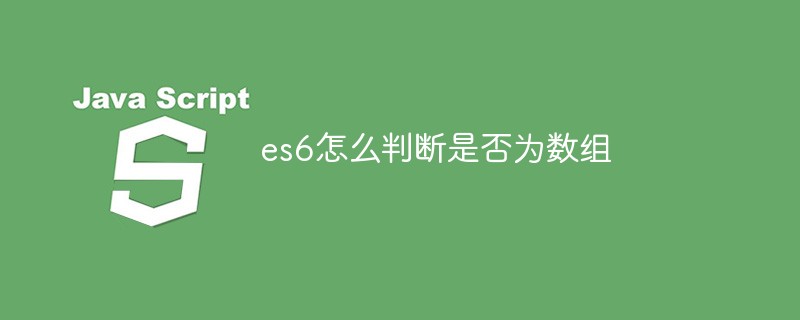 es6怎么判断是否为数组Apr 25, 2022 pm 06:43 PM
es6怎么判断是否为数组Apr 25, 2022 pm 06:43 PM在es6中,可以利用“Array.isArray()”方法判断对象是否为数组,若判断的对象是数组,返回的结果是true,若判断对象不是数组,返回的结果是false,语法为“Array.isArray(需要检测的js对象)”。
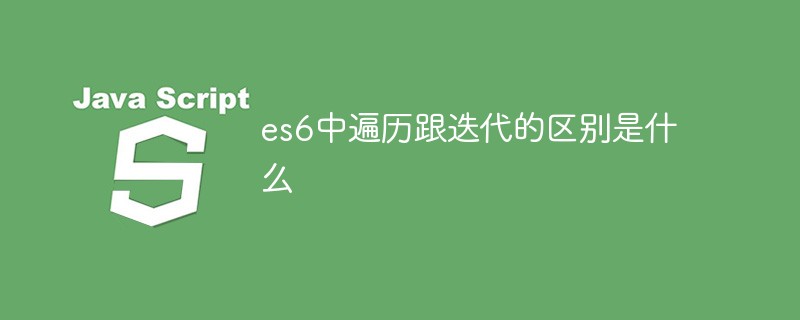 es6中遍历跟迭代的区别是什么Apr 26, 2022 pm 02:57 PM
es6中遍历跟迭代的区别是什么Apr 26, 2022 pm 02:57 PMes6中遍历跟迭代的区别是:遍历强调的是要把整个数据依次全部取出来,是访问数据结构的所有元素;而迭代虽然也是依次取出数据,但是并不保证取多少,也不保证把所有的数据取完,是遍历的一种形式。
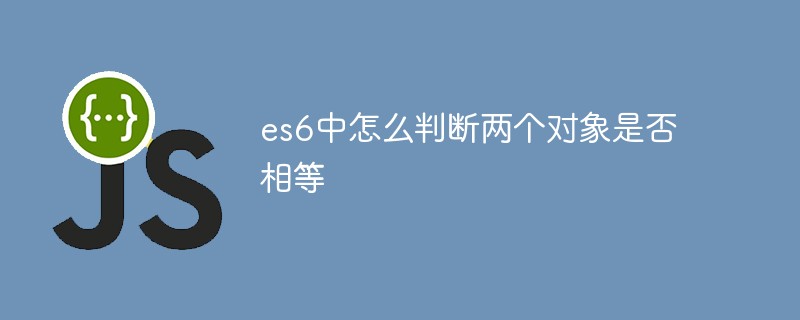 es6中怎么判断两个对象是否相等Apr 19, 2022 pm 03:34 PM
es6中怎么判断两个对象是否相等Apr 19, 2022 pm 03:34 PM在es6中,可用Object对象的is()方法来判断两个对象是否相等,该方法检测两个变量的值是否为同一个值,判断两个对象的引用地址是否一致,语法“Object.is(对象1,对象2)”;该方法会返回布尔值,若返回true则表示两个对象相等。
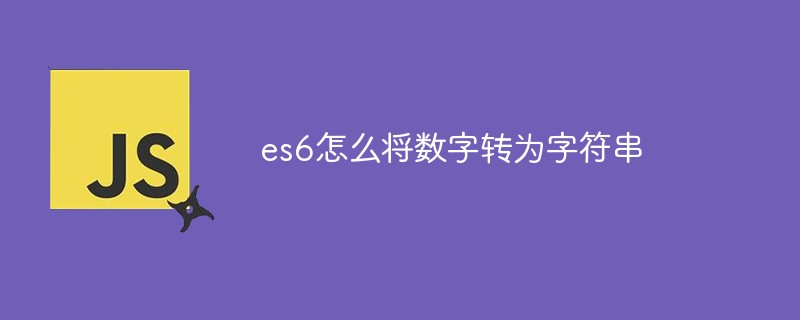 es6怎么将数字转为字符串Apr 19, 2022 pm 06:38 PM
es6怎么将数字转为字符串Apr 19, 2022 pm 06:38 PM转换方法:1、利用“+”给数字拼接一个空字符,语法“数字+""”;2、使用String(),可把对象的值转换为字符串,语法“String(数字对象)”;3、用toString(),可返回数字的字符串表示,语法“数字.toString()”。
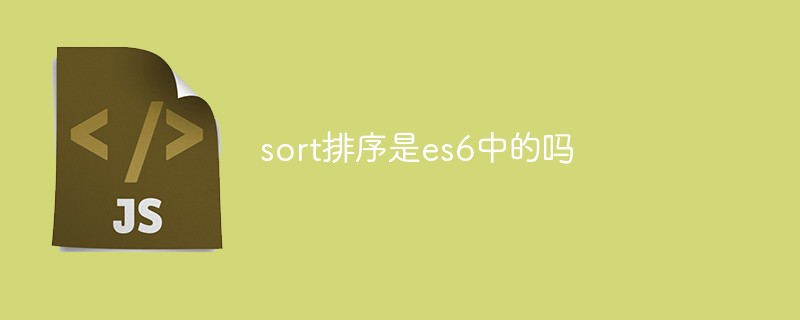 sort排序是es6中的吗Apr 25, 2022 pm 03:30 PM
sort排序是es6中的吗Apr 25, 2022 pm 03:30 PMsort排序是es6中的;sort排序是es6中用于对数组的元素进行排序的方法,该方法默认不传参,按照字符编码顺序进行排序,排序顺序可以是字母或数字,并按升序或降序,语法为“array.sort(callback(a,b))”。
 es6中assign的用法是什么May 05, 2022 pm 02:25 PM
es6中assign的用法是什么May 05, 2022 pm 02:25 PM在es6中,assign用于对象的合并,可以将源对象的所有可枚举属性复制到目标对象;若目标对象与源对象有同名属性,或多个源对象有同名属性,则后面的属性会覆盖前面的属性,语法为“Object.assign(...)”
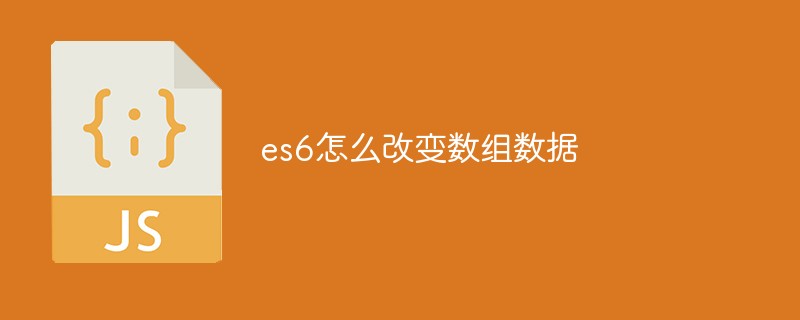 es6怎么改变数组数据Apr 26, 2022 am 10:08 AM
es6怎么改变数组数据Apr 26, 2022 am 10:08 AM改变方法:1、利用splice()方法修改,该方法可以直接修改原数组的内容,语法为“数组.splice(开始位置,修改个数,修改后的值)”;2、利用下标访问数组元素,并重新赋值来修改数组数据,语法为“数组[下标值]=修改后的值;”。
 import as在es6中的用法是什么Apr 25, 2022 pm 05:19 PM
import as在es6中的用法是什么Apr 25, 2022 pm 05:19 PM在es6中,import as用于将若干export导出的内容组合成一个对象返回;ES6的模块化分为导出与导入两个模块,该方法能够将所有的导出内容包裹到指定对象中,语法为“import * as 对象 from ...”。


熱AI工具

Undresser.AI Undress
人工智慧驅動的應用程序,用於創建逼真的裸體照片

AI Clothes Remover
用於從照片中去除衣服的線上人工智慧工具。

Undress AI Tool
免費脫衣圖片

Clothoff.io
AI脫衣器

AI Hentai Generator
免費產生 AI 無盡。

熱門文章

熱工具

mPDF
mPDF是一個PHP庫,可以從UTF-8編碼的HTML產生PDF檔案。原作者Ian Back編寫mPDF以從他的網站上「即時」輸出PDF文件,並處理不同的語言。與原始腳本如HTML2FPDF相比,它的速度較慢,並且在使用Unicode字體時產生的檔案較大,但支援CSS樣式等,並進行了大量增強。支援幾乎所有語言,包括RTL(阿拉伯語和希伯來語)和CJK(中日韓)。支援嵌套的區塊級元素(如P、DIV),

SecLists
SecLists是最終安全測試人員的伙伴。它是一個包含各種類型清單的集合,這些清單在安全評估過程中經常使用,而且都在一個地方。 SecLists透過方便地提供安全測試人員可能需要的所有列表,幫助提高安全測試的效率和生產力。清單類型包括使用者名稱、密碼、URL、模糊測試有效載荷、敏感資料模式、Web shell等等。測試人員只需將此儲存庫拉到新的測試機上,他就可以存取所需的每種類型的清單。

禪工作室 13.0.1
強大的PHP整合開發環境

Safe Exam Browser
Safe Exam Browser是一個安全的瀏覽器環境,安全地進行線上考試。該軟體將任何電腦變成一個安全的工作站。它控制對任何實用工具的訪問,並防止學生使用未經授權的資源。

PhpStorm Mac 版本
最新(2018.2.1 )專業的PHP整合開發工具






